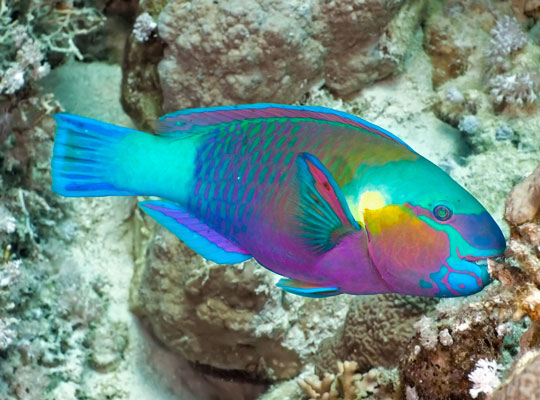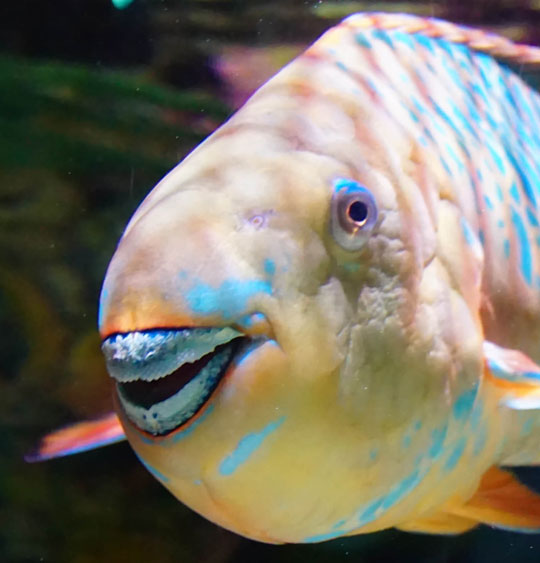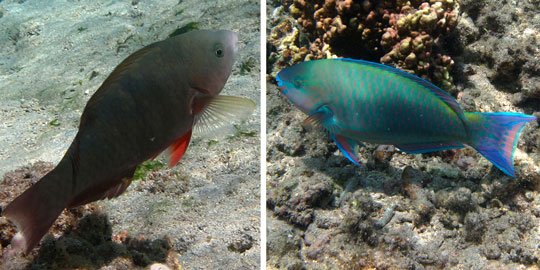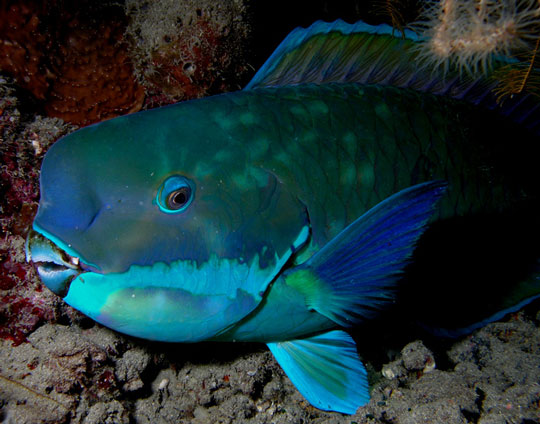|
About 26 years ago, Trish and I visited the Great Barrier Reef for the first time. This was also the first time we had ever snorkeled, and what an amazing place for a first snorkeling experience! One of the things I remember most was swimming through the water and hearing the sound of parrotfish chewing on pieces of coral. There were so many parrotfish doing this that the sound was loud and almost constant. We enjoyed watching the fish bite off pieces of coral rock and chew them up to extract whatever food they could get. What the heck is a Parrotfish? Parrotfish make up a family (Scaridae) with about 95 species. Many of them sport amazingly bright colors. They live primarily in coral reefs but can also be found in seagrass beds. The name parrotfish comes from their parrot-like beak, which they use to scrape algae from coral and rock surfaces, and often they actually bite off chunks of coral. Below is a queen parrotfish (I think). Amazing Facts about Parrotfish First let's take a look at the parrotfish's beak. Recent research has shown that parrotfish have some of the strongest teeth in the world. They really need these strong teeth because they spend much of their time munching on coral and chewing algae off the rocks. They don't actually consume the hard calcium carbonate coral rock, but they chew it up to get the polyps—the soft-bodied coral animals—and to get the algae that live inside the polyps, as well as bacteria living on the coral rocks. To be able to do this all day, parrotfish need amazingly hard teeth. Their teeth are actually made up of a material called fluorapatite, which has a striking crystalline structure. Fluorapatite is a biomineral (a mineral produced by living organisms), and it is the second-hardest biomineral known. In fact, a single square inch of parrotfish teeth can tolerate 530 tons of pressure without breaking. In case you're wondering, this is the the weight of about 88 elephants. Check out this parrotfish beak. Sticking your finger in this fish's mouth would not be a good idea. Not only are parrotfish teeth astoundingly strong, their configuration is unique. Each parrotfish had about 1,000 teeth. They are arranged in rows (up to 15 rows), and they are fused together to form a solid beak. When one row of teeth wears out, it simply falls out, and the next row back becomes the primary chewing row. Check out this video of feeding parrotfish. Because parrotfish chomp a lot of coral rock to get at the food it contains, they have to get rid of all that rock. Well, they poop most of it out as coral sand. First, they pulverize it with grinding teeth in their throats to get the goodies out of it, then the small bits pass through their body and are pooped out. A heavybeak parrotfish can produce about 2000 pounds (907 kg) of coral sand each year! They excrete so much of the stuff that, over time, it can pile up until it creates an island. Eventually, the island will accumulate organic matter until plants begin to grow. If you have ever been to a tropical coral island and enjoyed relaxing on a beautiful white-sand coral beach, that sand is actually parrotfish poop. Parrotfish have unusual and diverse life cycles. Most of the species are what we call sequential hermaphrodites. They start their lives as females then eventually turn into males. Along with this sex change, there is usually a dramatic change in color, as the males are often more brightly colored than the females. Weird, huh? Let's dig a little deeper. Parrotfish tend to swim around in schools that form when the group is fairly young (and therefore female). When the females in the school reach sexual maturity, the largest female in the group will transform into a male. That male then becomes the one responsible for fertilizing the eggs of the females in his school. To give you an idea of how different the colors can be, below is a female common parrotfish (on the left) and a male common parrotfish (on the right). There are all kinds of variations of this among parrotfish species. In some species, like the stoplight parrotfish, some of the fish start out as males, but others start out as females and later turn into males. In one species, the marbled parrotfish, the fish do not change their gender at all (the only species that doesn't). In some species the female is brightly colored and the male is dull. In many species the juveniles of both sexes are a different color from the adults of both sexes. As you can imagine, these various colors make it rather difficult to identify species. In fact, when scientists first started studying parrotfish, they identified over 350 different species, which is almost four times more than the actual number of species! Below is a blunthead parrotfish. So, the Parrotfish deserves a place in the A.A.H.O.F. (A-okay Animal Hall of Fame). FUN FACT: The word A-okay (or A-OK) originated in 1952, when it was used in an ad for Midvac Steels (the ad said, "A-OK for tomorrow's missile demands"). However, it didn't become popular until people at NASA started using it in 1961. The term was commonly used to specify that everything checked out. It could be an abbreviation of "All systems are OK." The word is still widely used today, and it generally means "Ok, perfect, or excellent." So, A-okay is another way to say awesome! Photo Credits:
Queen parrotfish #1 - DepositPhotos Parrotfish beak - DepositPhotoes Coral Sand Island - Depositphotos Female common parrotfish - Philippe Bourjon, CC BY-SA 3.0 via Wikimedia Commons Male common parrotfish - Philippe Bourjon, CC BY-SA 3.0 via Wikimedia Commons Blunthead parrotfish - Nhobgood, CC BY-SA 3.0 via Wikimedia Commons
0 Comments
Leave a Reply. |
Stan's Cogitations
Everyone needs a creative outlet. That's why I write. Archives
July 2024
|






 RSS Feed
RSS Feed